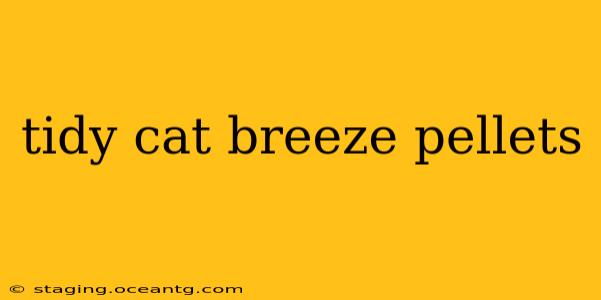Tidy Cats Breeze is a popular choice among cat owners seeking a low-dust, lightweight litter option. Its unique pellet formula promises clumping power and odor control, but how does it stack up against other litters on the market? This comprehensive guide will explore everything you need to know about Tidy Cats Breeze pellets, addressing common questions and concerns.
What Makes Tidy Cats Breeze Pellets Different?
Unlike traditional clay litters, Tidy Cats Breeze utilizes a unique, lightweight pellet formula made from natural minerals. These pellets are designed to absorb urine effectively, forming solid clumps that are easy to scoop. The low-dust nature is a significant advantage for cats and their owners alike, reducing the risk of respiratory irritation and keeping your home cleaner. The overall lightness also makes it easier to carry and pour, especially beneficial for those with mobility concerns.
How Well Do Tidy Cats Breeze Pellets Clump?
One of the most crucial aspects of any litter is its clumping ability. Tidy Cats Breeze pellets generally form firm, easily scoopable clumps, making litter box maintenance a breeze (pun intended!). However, the clumping effectiveness can vary depending on factors like the amount of urine absorbed and the frequency of scooping. Regular scooping is key to preventing the formation of large, messy clumps and maintaining optimal odor control. Many users report excellent clumping performance, especially when compared to other clumping litters.
Are Tidy Cats Breeze Pellets Dust-Free?
While marketed as low-dust, it's important to understand that no litter is entirely dust-free. Tidy Cats Breeze significantly reduces dust compared to traditional clay litters, making it a much better option for cats and owners sensitive to dust particles. The reduced dust contributes to a cleaner home environment, reducing the amount of litter tracked around the house. However, some users still report experiencing a small amount of dust, especially during pouring.
How Long Do Tidy Cats Breeze Pellets Last?
The longevity of Tidy Cats Breeze pellets depends on several factors, including the number of cats using the litter box, their individual habits, and the frequency of scooping. Generally, a single bag lasts longer than comparable clay litters due to the pellets' efficient absorption and clumping properties. Regular scooping maximizes the litter's lifespan, preventing unnecessary waste.
How Do Tidy Cats Breeze Pellets Compare to Other Litters?
Tidy Cats Breeze offers several advantages over traditional clay litters. Its lighter weight, low-dust nature, and effective clumping contribute to a more convenient and cleaner litter box experience. However, it may be slightly more expensive per bag compared to some other brands. Direct comparisons with other brands like World's Best Cat Litter (which uses corn) or brands focusing on crystal litters would depend on individual cat preferences and household priorities. Consider comparing factors like cost-effectiveness, clumping strength, odor control, and dust level when choosing the best litter for your cat.
Are Tidy Cats Breeze Pellets Safe for My Cat?
Tidy Cats Breeze is generally considered safe for cats, but always supervise your pet and monitor their behavior after introducing a new litter. If you observe any unusual symptoms such as vomiting, diarrhea, or skin irritation, discontinue use and consult your veterinarian. While the pellets are made from natural minerals, ingestion should be avoided.
What Are the Pros and Cons of Tidy Cats Breeze Pellets?
Pros:
- Low dust
- Lightweight
- Effective clumping
- Good odor control
- Generally longer-lasting than clay litters
Cons:
- Can be more expensive than some clay litters
- Not entirely dust-free (minimal dust reported)
- Some cats may be initially hesitant to use a new litter type
Ultimately, the best way to determine if Tidy Cats Breeze is right for your cat is to try it. Many pet stores offer smaller sample sizes, allowing you to test it before committing to a full-size bag. Pay attention to your cat's behavior and the litter's performance in your specific litter box to make an informed decision.
